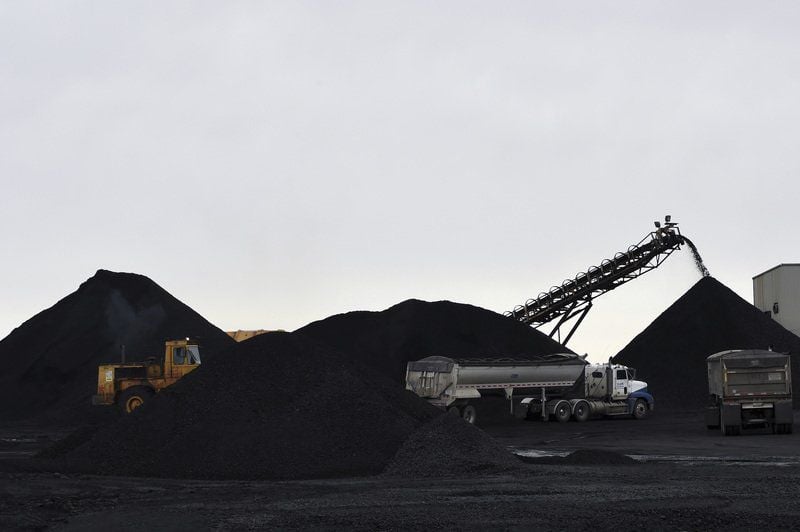Several documents of interest to IndianaDG readers were filed on 9/4/18 with the Indiana Supreme Court. IndianaDG has joined with several other groups as a Friend of the Court or Amici Curiae in a Legal Brief that was filed.
The attorney representing Michael Mullett and his wife Patti March who are Duke Energy Indiana customers in Columbus, IN, framed the issue on transfer on the first narrative page of the Petition:
Whether the Court of Appeals’ decision conflicts with multiple decisions of this Court and departs from fundamental principles of Indiana utility and appellate law by upholding a provision of a final order of the Indiana Utility Regulatory Commission which authorized the recovery through customer rates of $29 million paid by an investor-owned utility as damages for its breach of a purchased power agreement with an energy supplier which had previously been fully and finally adjudicated by the Seventh Circuit of the United States Court of Appeals and had caused energy not to be generated or delivered for the benefit of customers?
The arguments explaining why the Supreme Court should grant transfer, vacate the Court of Appeals decision, and remand the case to the Commission for additional proceedings and relief for Duke Energy Indiana customers (including but not limited to a refund of the $29 million) is then set forth in detail in the remainder of the Petition.
Here are the documents filed 9/4/18 with the Court that includes Indiana Distributed Energy Alliance (IndianaDG):
Mullett v DEI--Motion to Appear as Amici Curiae--9-4-18
Mullett v DEI--Appearance of Counsel for Amici Curiae--9-4-18
Mullett v DEI--Amici Curiae Brief--9-4-18
Here is an excerpt from the Amici Curiae brief:
SUMMARY OF ARGUMENT
This case presents a fundamental question of law and fairness about whether Indiana utility consumers should be forced to pay higher rates and charges when a monopoly electric utility breaches a contract with a third-party energy provider, and the Indiana Utility Regulatory Commission (“Commission” or “IURC”) fails to fully analyze and determine the reasonableness and prudency of the utility’s breach of contract actions that created the financial liability. Duke Energy Indiana LLC (“Duke Energy”) breached its contract with the Benton County Wind Farm (“Benton”) that required Duke Energy to purchase 100 megawatts of wind energy and to procure
transmission to deliver the energy to the electricity grid managed by the Carmel, Indiana based Midcontinent Independent System Operator (“MISO”). Benton sued Duke Energy for damages
due to the breach of contract. In 2016, the United States Court of Appeals for the Seventh Circuit ultimately ruled in Benton’s favor. The U.S. Court of Appeals held that Duke Energy was at fault and liable for breach of contract based on its failure to reserve transmission capacity to carry the wind energy that was generated, and ordered Duke Energy to pay Benton damages for its breach of contract:
….Duke must pay Benton. The risk of inadequate transmission was contemplated by the contracting parties and allocated to Duke. By accepting this risk, Duke enabled Benton to finance its project; otherwise potential investors might have feared exactly the overcapacity situation that has come to pass. Duke wanted
Benton’s facilities to exist and called them into existence by promising to pay even if a shortfall of transmission services should lead to curtailment of deliveries.
Benton County Wind Farm v. Duke Energy Indiana, 843 F. 3d 298, 303-04 (7th Cir. 2016). The U.S. Court of Appeals remanded the case to determine damages, and the parties reached a settlement by which Duke Energy agreed to pay damages of $29 million to Benton.
After the settlement, Duke Energy filed a fuel adjustment case at the Commission requesting authorization to charge consumers for the entirety of the $29 million of its damages resulting from its breach of contract with Benton County. Application of Duke Energy Indiana for a Change in Its Fuel Cost Adjustment, Cause No. 38707 FAC 113, Sept. 27, 2017. Under Indiana law, the Commission must specifically examine and find any such charges to be just and
reasonable before it can permit a utility, such as Duke Energy, to force consumers to pay the charges–here, the $29 million in damages. Ind. Code. §8-1-2-4. Instead of analyzing the reasonableness of Duke Energy’s actions in breaching the contract, however, the Commission only looked at whether the amount of the settlement was reasonable. By asking and addressing
the wrong question, the Commission reached the wrong answer by failing to properly apply the just and reasonable standard and violating Indiana law in a manner that raises rates to Indiana
consumers without fundamental fairness. That result is unfair and is contrary to law.
Appellants Mullett and March argued on appeal that forcing consumers to pay these higher charges of $29 million was unreasonable as a matter of law because Duke Energy’s
breach of contract caused the financial damages and the loss of wind energy service.
Accordingly, Duke Energy and its shareholders should be responsible for Duke Energy’s errors. The Indiana Court of Appeals ruled in Duke Energy’s favor by joining the Commission in again
focusing on the reasonableness of the settlement amount, rather than Duke Energy’s breach that caused the damages and loss of service. Mullett v. Duke Energy Indiana, Court of Appeals Case
No. 93A02-1710-EX-2468 Opinion (May 21, 2018). With due respect, the Indiana Court of Appeals’ decision is erroneous and contrary to law. If left to stand, it sets an unfortunate precedent allowing consumers to be charged for a monopoly utility’s unreasonable decision to breach its contractual obligations, and it risks continued unfairness and illegality in future such
cases. Consumers should not be forced to pay for these types of utility mistakes.
The Supreme Court should grant the Petition to Transfer in this case in order to fully consider the important issues on appeal. The Supreme Court should then reverse and remand the Indiana Appellate Court’s decision and require the Commission to fully and fairly determine the reasonableness of Duke Energy’s actions in breaching its contract, as well as the fairness and legality in these circumstances of charging the entirety of the consequent damages to consumers who bear no fault at all.
ARGUMENTS:
- Indiana law does not allow Duke Energy to force customers to pay unreasonable and unjust higher utility charges for damages resulting from its breach of contract.
- Both the Indiana Utility Regulatory Commission and the Indiana Appellate Court asked the wrong question and then reached the wrong answer.
Here is what the Indiana Court of Appeals said in their order dated 5/21/18:
Case Summary
Appellee Duke Energy Indiana, LLC (“Duke”) and Benton County Wind Farm (the “Wind Farm”) entered into a contract under which Duke agreed to buy power from the Wind Farm. In 2013, a dispute arose after Duke failed to buy energy from the Wind Farm. The Wind Farm filed suit claiming that Duke owed it money for lost production under the parties’ contract. The parties eventually settled and Duke went to the Indiana Utility Regulatory Commission (the “Commission”) seeking to recover its costs from ratepayers. Appellants Michael A. Mullett and Patricia N. March (the “Appellants”) intervened in the proceeding and objected to Duke’s request. After a hearing on the matter, the Commission approved Duke’s request to recover the costs from its ratepayers over a twelve-month period.
Appellants now appeal arguing that the Commission’s order is contrary to law because the damages are “liquidated” and “hypothetical” and it amounts to impermissible retroactive ratemaking. Finding that substantial evidence supports the Commission’s order and no other error, we affirm.
The Indiana Court of Appeals goes on as follows:
Facts and Procedural History
In 2006, Duke and the Wind Farm entered into a Renewable Wind Energy Power Purchase Agreement (“PPA”) in which Duke agreed to purchase a portion of the energy generated by the Wind Farm. After purchasing the energy from the Wind Farm, Duke would immediately sell it into the Midcontinent Independent System Operator (“MISO”) wholesale energy market. The Indiana Utility Regulatory Commission (“the Commission”) approved the PPA in its entirety in 2006, concluding that “the terms of the Wind [PPA were] reasonable.” Duke App. Vol. II, p. 17.
The Commission also recognized that Duke would be incurring significant costs in connection with the PPA. Consequently, in order to further the Commission’s policy of encouraging the development of renewable resources, the Commission authorized Duke to recover all of its PPA costs from ratepayers for the entire twenty-year term:
[T]he Commission finds that Duke Energy Indiana should be authorized to recover the Wind [PPA] costs provided for in the contract for the full 20 year term of that contract[.]
Duke App. Vol. II, p. 19.
Following changes to certain rules and regulations in 2013, a dispute arose regarding the extent of Duke’s contractual obligations to the Wind Farm. Duke believed that based upon the parties’ contract, it was only required to accept and pay for energy that the Wind Farm generated and delivered to Duke. The Wind Farm, however, interpreted the contract to mean that Duke had to pay for lost production in addition to the power it delivered to Duke.
The Wind Farm sued Duke in federal court to resolve the disputed contract interpretation. The federal district court agreed with Duke’s interpretation and granted Duke’s motion for summary judgement in 2015. The Wind Farm appealed to the Seventh Circuit, which agreed with the Wind Farm’s interpretation, reversed the district court’s ruling, and remanded with instructions for a determination of damages, i.e. how much Duke owed the Wind Farm for lost production.
The Wind Farm and Duke entered into settlement negotiations. At the conclusion of the settlement negotiations, the parties agreed on $29 million, which Duke believed was approximately equal to what it would have cost Duke and its ratepayers had the parties agreed with the Wind Farm’s contact interpretation at the outset.
Duke reported to the Commission in its Fuel Cost Adjustment (“FAC”) filing on July 27, 2017, that the dispute between Duke and the Wind Farm had settled.1 In its report, Duke also indicated its intention to recover the lost production costs from ratepayers over a six-month period.2 The Office of Utility Consumer Counselor (the “OUCC”) had no objection to Duke’s recovery of the $29 million as costs Duke incurred under the PPA, but requested that the recovery be spread over a twelve-month period rather than the six-month period Duke had proposed. Duke agreed to spreading the recovery out over a twelve-month period. On September 21, 2017, Duke filed its Proposed Form of Order in which it proposed to recover the $29 million through rates over a twelve-month period.
Meanwhile, Appellants intervened in this proceeding as ratepayers and filed a Brief in Opposition to Approval of Liquidated Damages Payment as an Expense Recoverable through Rates as their legal objection to Duke’s Proposed Order. Thereafter, Duke filed its Response to Appellant’s Brief in Opposition. On September 27, 2017, the Commission entered its final order approving proposed Duke’s rate recovery over a twelve-month period.








